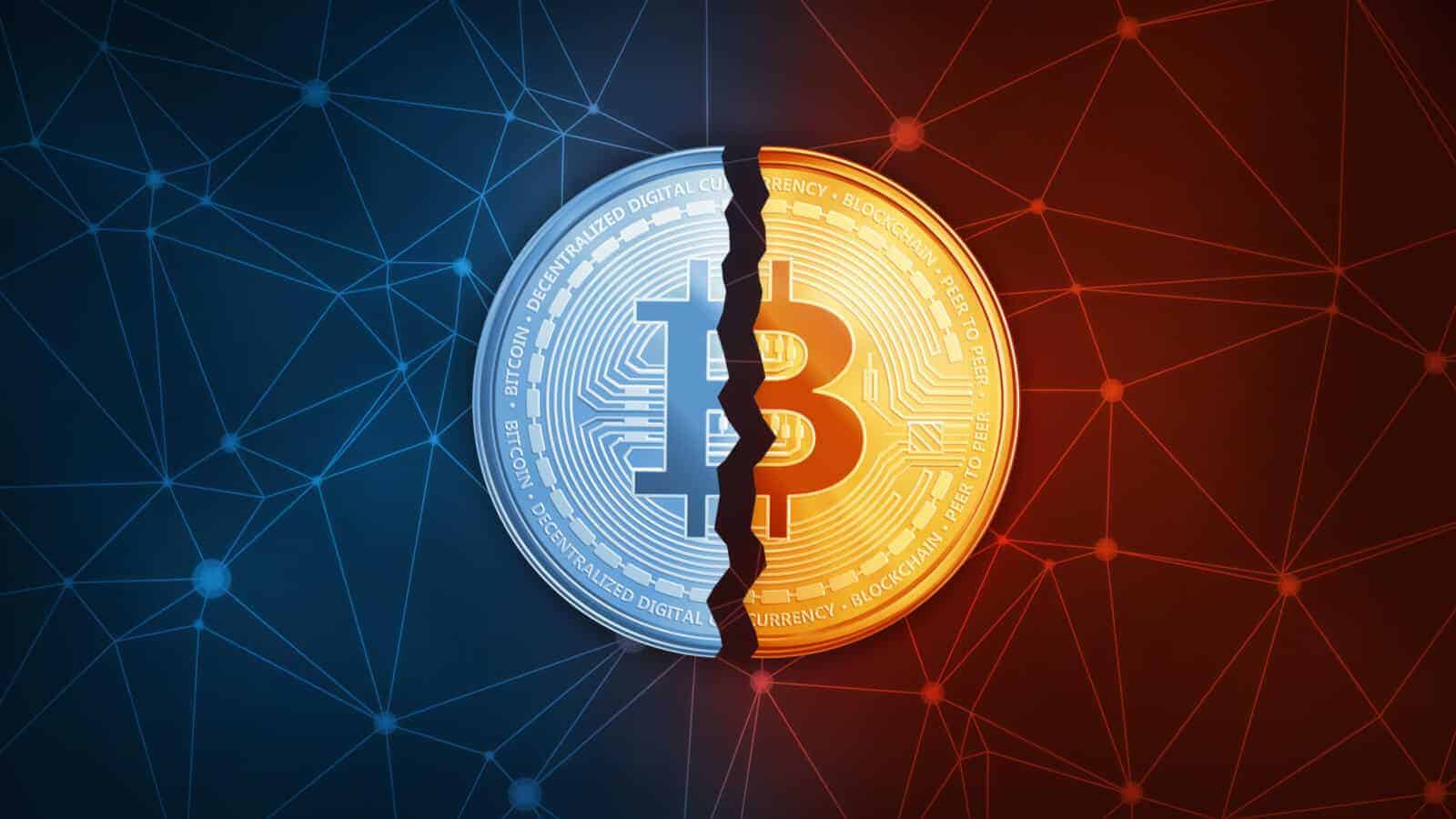Introduction
Bitcoin, the world’s first decentralized cryptocurrency, has brought about significant changes in the world of finance and technology. Its revolutionary nature and booming popularity have led to the emergence of various offshoots, known as Bitcoin forks. Understanding what a Bitcoin fork is and why it occurs is essential for anyone looking to delve deeper into the world of cryptocurrencies.
A Bitcoin fork can be seen as a divergence from the main Bitcoin blockchain, resulting in the creation of a new and separate version of the cryptocurrency. This happens when the developers and community members of Bitcoin cannot reach a consensus on proposed changes or updates to the network.
Bitcoin forks can be categorized into two main types: soft forks and hard forks. Soft forks are backward-compatible upgrades to the Bitcoin protocol, while hard forks involve fundamental changes that are not compatible with the previous version.
Bitcoin forks have gained attention due to several reasons. Firstly, they offer opportunities for innovation and experimentation in the cryptocurrency ecosystem. Secondly, forks can result in the creation of new cryptocurrencies with different features, addressing specific market demands or challenges. Lastly, forks can sometimes lead to disputes and debates within the Bitcoin community.
This article aims to provide a comprehensive overview of Bitcoin forks, exploring their types and the reasons behind their occurrence. By examining some notable examples of Bitcoin forks, such as Bitcoin Cash, Bitcoin Gold, and Bitcoin SV, readers will gain a deeper understanding of the impact and significance of these forks in the world of cryptocurrencies.
What is a Bitcoin Fork?
A Bitcoin fork refers to a significant change in the underlying software protocol of the Bitcoin blockchain. It occurs when a group of developers or community members decides to introduce modifications to the existing codebase, resulting in the creation of a new version of Bitcoin. This new version operates on a different set of rules and can potentially have unique features and characteristics.
At its core, a Bitcoin fork can be seen as a branching of the blockchain into two separate paths. The original path follows the existing rules and continues with the established protocol, while the new path operates on the updated rules introduced by the fork. Both paths share the same transaction history up until the fork occurs, after which they diverge and become independent.
The primary motivation behind a Bitcoin fork is usually to address specific issues or implement changes that the community deems necessary. These changes can range from improving scalability and transaction speed to introducing new functionalities, such as smart contracts or enhanced privacy features.
Bitcoin forks can be temporary or permanent. Temporary forks, also known as soft forks, are backward-compatible upgrades. They do not result in a permanent split of the blockchain and maintain compatibility with the previous version. Soft forks typically introduce new rules while maintaining backward compatibility, allowing all participants to continue using the same blockchain.
On the other hand, permanent forks, known as hard forks, signify a non-compatible update to the Bitcoin protocol. These forks result in a permanent divergence of the blockchain, with the new version having its own set of rules and potentially different features. Participants must choose which fork to support, leading to the creation of two distinct cryptocurrencies.
It is important to note that not all Bitcoin forks are universally accepted or recognized. The level of community support, acceptance, and adoption varies for each fork. Some forks gain significant traction and establish themselves as independent cryptocurrencies, while others may fade into obscurity or remain small-scale experiments.
Overall, Bitcoin forks play a crucial role in the evolutionary development of cryptocurrencies. They encourage innovation, introduce changes that address specific needs, and provide opportunities for the community to participate in shaping the future of the blockchain. By understanding the concept of Bitcoin forks, investors and enthusiasts can stay informed about the latest developments in the cryptocurrency landscape.
Why do Bitcoin Forks occur?
Bitcoin forks occur due to various reasons, primarily driven by differing viewpoints within the community regarding proposed changes and updates to the Bitcoin protocol. These forks represent a divergence of opinions on the direction of the cryptocurrency and can arise from technical, ideological, or governance-related factors.
One of the main reasons for Bitcoin forks is the need to address scalability concerns. As the popularity of Bitcoin grows, the number of transactions processed on the blockchain increases, potentially leading to congestion and slower transaction confirmation times. Forks may be initiated to introduce changes aimed at improving the scalability of the network, such as increasing the block size limit or implementing off-chain solutions.
Ideological differences also play a significant role in driving Bitcoin forks. The decentralized nature of Bitcoin gives rise to debates about the fundamental principles the cryptocurrency should adhere to. Forks can occur when there are disagreements regarding issues like privacy, governance, or the role of miners within the network. In some cases, forks may represent a divergence towards more permissive or privacy-focused approaches.
Another factor behind Bitcoin forks is the desire to experiment with new features or functionalities. Developers and community members may propose changes to the Bitcoin protocol that introduce innovative technologies like smart contracts or enhanced privacy solutions. Forks allow for the implementation and testing of these new features in a separate environment, without risking the stability of the main Bitcoin network.
Disagreements over governance and decision-making processes can also lead to Bitcoin forks. The decentralized nature of Bitcoin means that consensus must be reached among various stakeholders to implement changes. When consensus cannot be achieved, forks can occur as different groups choose to follow their preferred path forward. These forks may reflect differing opinions on the power distribution, decision-making structures, or the involvement of external entities in the development and governance of Bitcoin.
In summary, Bitcoin forks occur due to a combination of technical, ideological, and governance-related factors. Scalability concerns, ideological differences, the desire for experimentation, and governance disputes all contribute to the initiation of forks. These forks allow for the exploration of new ideas, the resolution of contentious issues, and the evolution of the Bitcoin ecosystem.
Types of Bitcoin Forks
Bitcoin forks can be categorized into two main types: soft forks and hard forks. Each type represents a different approach to implementing changes and updates to the Bitcoin protocol, with varying implications for the network and its participants.
Soft Forks:
A soft fork is a backward-compatible upgrade to the Bitcoin protocol. It involves introducing rule changes that are within the existing protocol’s ruleset. This means that participants who have not upgraded to the new version can still validate and process transactions on the updated blockchain.
Soft forks typically involve tightening the rules or adding restrictions to the existing protocol. This ensures that all transactions and blocks in the new version remain valid according to the previous rules. Soft forks are often implemented through a majority consensus, requiring most nodes and miners to adopt the upgrade for it to be successful.
One example of a soft fork is the implementation of Segregated Witness (SegWit) in Bitcoin. SegWit aimed to improve transaction capacity by modifying the way certain data was stored in blocks, without requiring a fundamental change to the block size limit.
Hard Forks:
Hard forks, on the other hand, involve significant changes to the Bitcoin protocol that are not compatible with the previous version. These forks result in a permanent divergence of the blockchain, creating two separate and independent networks with their own rules and features.
Participants of a hard fork must choose which version of the blockchain to support. This choice typically involves deciding to follow the newly created fork or stick with the original version. Hard forks can be contentious, as they often lead to debates and disagreements within the community.
Hard forks can occur due to differing opinions on fundamental issues like block size, consensus mechanisms, or governance structures. Participants who are unsatisfied with the current state of Bitcoin may initiate a hard fork to propose radical changes or address perceived shortcomings.
Examples of notable hard forks include Bitcoin Cash, which resulted from a disagreement over the block size limit, and Bitcoin Gold, which aimed to decentralize the mining process by implementing a new mining algorithm.
In summary, soft forks are backward-compatible upgrades that introduce rule changes within the existing protocol, while hard forks involve incompatible changes that lead to a permanent divergence of the blockchain. Both types of forks play a role in shaping the evolution of Bitcoin and provide avenues for implementing technical improvements, experimenting with new features, and addressing contentious issues within the community.
Soft Forks
A soft fork is a type of Bitcoin fork that involves making backward-compatible upgrades to the existing protocol. It introduces changes within the established ruleset, allowing participants who have not upgraded to the new version to continue operating on the same blockchain.
Soft forks aim to add new features, improve functionality, or address specific issues within the Bitcoin network. The changes made during a soft fork generally involve tightening the existing rules or adding restrictions, ensuring that all transactions and blocks remain valid under the previous protocol.
Soft forks typically require a majority consensus among the network’s nodes and miners to be successfully implemented. This means that a significant portion of the participants must adopt and upgrade to the new version for it to function effectively. If the majority of the network does not adopt the changes, the soft fork may result in a temporary split in the blockchain, known as a chain split, but ultimately only the longer chain will be recognized as valid.
One notable example of a soft fork in Bitcoin is the implementation of Segregated Witness (SegWit). SegWit was introduced to address the scalability issue of Bitcoin by modifying how certain data, specifically the transaction signature data, was stored in blocks. The segregated data allowed for more transactions to be included in a block without increasing the block size explicitly.
By implementing SegWit, soft fork proponents aimed to increase the transaction capacity of the blockchain while maintaining backward compatibility. Participants who did not upgrade to the new version could still validate and process transactions on the updated blockchain, although they would not benefit from the performance improvements provided by SegWit.
Soft forks are generally viewed as less disruptive compared to hard forks because they do not lead to a permanent split in the blockchain. They allow for gradual upgrades and changes to the protocol while minimizing operational disruptions for network participants. However, achieving consensus for a soft fork can still require considerable coordination and cooperation within the community.
In summary, soft forks are backward-compatible upgrades to the Bitcoin protocol. They introduce changes within the existing ruleset, aiming to add new features or address specific issues. Soft forks require majority consensus for successful implementation and allow participants who have not upgraded to the new version to continue operating on the same blockchain. Examples of soft forks include the implementation of Segregated Witness (SegWit) in Bitcoin.
Hard Forks
Hard forks are a type of Bitcoin fork that involves significant and non-compatible changes to the existing protocol. Unlike soft forks, which are backward-compatible, hard forks result in a permanent split in the blockchain, creating two separate and independent networks with their own rules and features.
Hard forks typically occur when there are disagreements within the Bitcoin community regarding fundamental aspects of the protocol, such as block size limits, consensus mechanisms, or governance structures. These differences in opinion often lead to competing visions for the future of Bitcoin, ultimately resulting in a hard fork.
During a hard fork, participants of the Bitcoin network must choose which version of the blockchain they will support. This decision often involves deciding to follow the newly created fork or sticking with the original version. The choice is typically made by individual users, miners, developers, and other stakeholders based on their preferences, beliefs, and perceived benefits of each fork.
Hard forks can be contentious, as they can lead to debates, disagreements, and community fragmentation. Each group supporting a different fork may try to rally participants to their respective side, aiming to gain majority support and establish their version of Bitcoin as the dominant one.
Notable examples of hard forks in the history of Bitcoin include Bitcoin Cash (BCH) and Bitcoin Gold (BTG). Bitcoin Cash originated from a disagreement within the community regarding the block size limit. Its proponents argued for an increase in the block size to accommodate more transactions and improve scalability. Bitcoin Cash created a separate chain with a larger block size, allowing for faster and cheaper transactions compared to Bitcoin.
Bitcoin Gold (BTG), on the other hand, aimed to make mining more decentralized by introducing a new mining algorithm that can be performed with regular consumer-grade hardware. It sought to reduce the dominance of specialized mining equipment, such as ASICs, and provide a more level playing field for participants.
Hard forks can have different outcomes and levels of success. Some forks gain significant traction, establish themselves as independent cryptocurrencies, and garner support from users and exchanges. Others may struggle to gain recognition and adoption, resulting in a less prominent or unsuccessful fork.
In summary, hard forks involve significant and non-compatible changes to the Bitcoin protocol, resulting in a permanent split of the blockchain. They usually occur due to disagreements within the community regarding fundamental aspects of the cryptocurrency. Participants must choose which fork to support, leading to the creation of independent networks. Examples of hard forks include Bitcoin Cash (BCH) and Bitcoin Gold (BTG).
Examples of Bitcoin Forks
Bitcoin, being the pioneering cryptocurrency, has witnessed several notable forks throughout its history. These forks have resulted in the creation of new cryptocurrencies with varying features and community support. Let’s explore some of the most significant examples of Bitcoin forks:
Bitcoin Cash (BCH):
Bitcoin Cash, initially launched in August 2017, emerged from a contentious hard fork within the Bitcoin community. The disagreement centered around the block size limit, with supporters of Bitcoin Cash advocating for an increase to enable faster and cheaper transactions. Bitcoin Cash increased the block size to 8 megabytes, enabling higher transaction capacity compared to Bitcoin. It positioned itself as a peer-to-peer electronic cash system and emphasized its potential for everyday transactions.
Bitcoin Gold (BTG):
Bitcoin Gold, launched in October 2017, aimed to address the issue of mining centralization by introducing a new mining algorithm. The algorithm, called Equihash, was specifically designed to be resistant to specialized mining hardware, such as ASICs. Bitcoin Gold strived to create a more decentralized mining ecosystem, allowing ordinary users to mine the cryptocurrency using consumer-grade hardware. Its mission was to provide a fairer and more accessible mining experience for participants.
Bitcoin SV (BSV):
Bitcoin SV, short for Bitcoin Satoshi Vision, emerged from a contentious hard fork of Bitcoin Cash in November 2018. The primary driving force behind the fork was a disagreement over the direction of Bitcoin Cash, with the Bitcoin SV faction seeking to restore what they believed to be the original vision of Bitcoin as outlined by its creator, Satoshi Nakamoto. Bitcoin SV aimed to achieve greater scalability by increasing the block size limit, aiming to support more transactions and enable micropayments on-chain.
Bitcoin Diamond (BCD):
Bitcoin Diamond, launched in November 2017, aimed to enhance Bitcoin’s privacy and transaction speed. It introduced several features, including increased block size, replay protection, and enhanced encryption. Bitcoin Diamond aimed to make transactions faster and cheaper while also improving privacy by implementing features like private key operation and zero-knowledge proofs.
These examples highlight the diverse motivations behind Bitcoin forks, ranging from scalability improvements to ideological disagreements and innovative feature implementations. Each fork has created its own distinct cryptocurrency with its own set of supporters, community, and use cases.
It is important to note that the success and adoption of these forks differ. While some forks have gained significant traction and are actively traded on cryptocurrency exchanges, others may have limited visibility or struggle to gain widespread acceptance.
In summary, Bitcoin has experienced several noteworthy forks, including Bitcoin Cash, Bitcoin Gold, Bitcoin SV, and Bitcoin Diamond. These forks have introduced changes such as increased block sizes, modified mining algorithms, and added privacy features, reflecting different perspectives and addressing specific needs within the cryptocurrency ecosystem.
Bitcoin Cash
Bitcoin Cash (BCH) is one of the most prominent examples of a Bitcoin fork that has gained significant traction and recognition in the cryptocurrency ecosystem. It emerged as a result of a contentious hard fork within the Bitcoin community in August 2017.
The main point of disagreement that led to the creation of Bitcoin Cash was the block size limit. Bitcoin Cash proponents argued that the original Bitcoin blockchain had become congested and unable to handle a growing number of transactions effectively. They believed that increasing the block size would improve scalability and enable faster and cheaper transactions.
Bitcoin Cash increased the block size limit to 8 megabytes, compared to the 1 megabyte limit of the original Bitcoin blockchain. This change allowed for a higher transaction capacity, aiming to make Bitcoin Cash a more practical option for everyday transactions.
With its larger block size, Bitcoin Cash positioned itself as a peer-to-peer electronic cash system, emphasizing its potential as a means of everyday transactional exchange. Its proponents envisioned Bitcoin Cash as fulfilling the original vision of Bitcoin as a decentralized digital currency that could be used for everyday purchases.
Since its inception, Bitcoin Cash has gained support from various cryptocurrency exchanges and wallet providers, making it more accessible to users. It has also seen merchant adoption, with some businesses accepting Bitcoin Cash as a form of payment.
It is important to highlight that Bitcoin Cash is separate from Bitcoin (BTC) and operates on its own blockchain. The two cryptocurrencies have distinct transaction histories and are not directly compatible with each other. Therefore, owning Bitcoin does not automatically mean having an equal amount of Bitcoin Cash.
Bitcoin Cash has attracted a dedicated community of supporters who believe in its vision and its potential as a scalable digital currency. However, it has also faced criticism and skepticism, with debates over its utility, centralization concerns, and challenges in gaining broader adoption.
Despite the controversies and varying opinions surrounding Bitcoin Cash, it remains a significant player in the cryptocurrency market. Its existence highlights the ability of the Bitcoin protocol to evolve and accommodate different views and approaches, expanding the possibilities within the cryptocurrency ecosystem.
In summary, Bitcoin Cash (BCH) is a notable Bitcoin fork that emerged from a hard fork within the Bitcoin community. It introduced a larger block size limit to improve scalability and enable faster, cheaper transactions. Bitcoin Cash positions itself as a peer-to-peer electronic cash system, aiming to fulfill the original vision of Bitcoin. While it has gained support and recognition, it also faces criticism and challenges in gaining widespread adoption.
Bitcoin Gold
Bitcoin Gold (BTG) is a significant Bitcoin fork that was created in October 2017 with the aim of addressing concerns regarding mining centralization within the Bitcoin network. It sought to democratize the mining process and make it more accessible to everyday users by introducing a new mining algorithm.
One of the primary motivations behind the creation of Bitcoin Gold was the dominance of specialized mining hardware known as ASICs (Application-Specific Integrated Circuits). These highly efficient and powerful machines gave a significant advantage to those who could afford them, leaving casual miners at a disadvantage.
To address this issue, Bitcoin Gold introduced a new mining algorithm called Equihash, which is resistant to ASICs. Equihash allows for mining using consumer-grade hardware, such as graphics processing units (GPUs), enabling a more level playing field for participants and reducing the centralization of mining power in the hands of a few.
With its emphasis on decentralization and accessibility, Bitcoin Gold aimed to bring back the idea of mining Bitcoin using personal computers and everyday devices. This approach aligned with the original vision of Bitcoin, which emphasized a decentralized network that anyone can participate in.
Bitcoin Gold shares a transaction history with Bitcoin up until the fork date, meaning that anyone holding Bitcoin at the time of the fork automatically became a Bitcoin Gold holder. However, Bitcoin Gold operates on a separate blockchain with its own set of rules and features.
Since its creation, Bitcoin Gold has gained a dedicated community of supporters and has been listed on various cryptocurrency exchanges, allowing for trading and liquidity. However, it should be noted that the adoption and recognition of Bitcoin Gold have not reached the same level as Bitcoin or some other major cryptocurrencies.
As with any cryptocurrency, Bitcoin Gold is not without its critics and challenges. It has faced skepticism regarding its ability to achieve its goals of decentralization and widespread mining participation. Additionally, like other Bitcoin forks, it is subject to the volatility and market forces that affect the broader cryptocurrency ecosystem.
In summary, Bitcoin Gold (BTG) is a Bitcoin fork launched with the aim of decentralizing the mining process and making it more accessible to a broader range of participants. It introduced the Equihash mining algorithm, which is resistant to specialized mining hardware, such as ASICs. While it has gained a dedicated community, Bitcoin Gold still faces challenges in achieving widespread adoption and recognition in the cryptocurrency market.
Bitcoin SV
Bitcoin SV (Bitcoin Satoshi Vision), often abbreviated as BSV, is a Bitcoin fork that emerged from a contentious hard fork of Bitcoin Cash (BCH) in November 2018. The primary motivation behind the creation of Bitcoin SV was a disagreement within the Bitcoin Cash community regarding the direction and development of the cryptocurrency.
The Bitcoin SV faction believed that Bitcoin Cash had deviated too far from what they considered the original vision of Bitcoin as detailed by its creator, Satoshi Nakamoto. They aimed to restore what they saw as the true essence of Bitcoin, with a focus on scalability, stability, and adherence to the original principles of the protocol.
Bitcoin SV aimed to achieve greater scalability by increasing the block size limit from 32 megabytes to 128 megabytes to accommodate a higher volume of transactions. The larger block sizes were seen as a means to support more transactions and enable micropayments on-chain.
Additionally, Bitcoin SV sought to provide a stable protocol and development environment, aiming for a more predictable and trustworthy blockchain. It emphasized the importance of maintaining backward compatibility, minimal protocol changes, and seeking input from miners and businesses in the development process.
From a governance perspective, Bitcoin SV aimed for on-chain scalability, where more transactions could be processed on-chain without relying heavily on second-layer solutions. The focus was to prioritize on-chain capacity and ensure a robust and scalable network.
Bitcoin SV has garnered some support from individuals and businesses within the cryptocurrency community. It has also been listed on various cryptocurrency exchanges, allowing for trading and liquidity in the market.
However, it is important to note that Bitcoin SV has also faced criticism and skepticism. Disagreements within the Bitcoin Cash community, transition challenges, and concerns over centralization have been subjects of ongoing debates and discussions surrounding Bitcoin SV.
In summary, Bitcoin SV (BSV) is a Bitcoin fork that emerged from the Bitcoin Cash (BCH) blockchain. It represents a faction that sought to restore what they believed was the original vision of Bitcoin, emphasizing scalability, stability, and adherence to the core principles of the protocol. Bitcoin SV aims to achieve greater scalability through increased block sizes and prioritizes on-chain capacity. While it has gained some support, it has also faced criticism and challenges on its path towards wider recognition and adoption.
Conclusion
Bitcoin forks have played a significant role in the evolution of the cryptocurrency landscape. They have provided avenues for innovation, addressed scalability concerns, and catered to differing perspectives within the Bitcoin community. These forks have resulted in the creation of new cryptocurrencies with unique features, allowing for experimentation and the exploration of alternative approaches to blockchain technology.
Soft forks, which are backward-compatible upgrades, have allowed for gradual improvements to the Bitcoin protocol while maintaining compatibility with the existing network. They have introduced changes such as Segregated Witness (SegWit), which aimed to improve scalability and transaction capacity.
On the other hand, hard forks, which involve non-compatible changes, have led to the emergence of separate networks with their own rules and characteristics. Examples of hard forks include Bitcoin Cash, Bitcoin Gold, and Bitcoin SV, each driven by different motivations and addressing specific challenges or philosophical differences.
Bitcoin forks have faced varying levels of success and acceptance in the cryptocurrency market. Some forks, such as Bitcoin Cash and Bitcoin SV, have gained significant recognition and support from communities, businesses, and exchanges. Others may have faced challenges in achieving widespread adoption and recognition.
It is important for cryptocurrency enthusiasts and investors to stay informed about Bitcoin forks and their implications. Understanding the motivations behind forks, their technical aspects, and the levels of community support can provide insights into the potential impact of these forks on the broader cryptocurrency ecosystem.
As the cryptocurrency landscape continues to evolve, we can expect further forks and developments that will shape the future of digital currencies. The ability of the Bitcoin protocol to adapt and accommodate different viewpoints and modifications makes it a dynamic and resilient system.
By recognizing the significance of Bitcoin forks and staying engaged with the ongoing discussions and developments within the community, individuals can make informed decisions and stay at the forefront of the ever-changing cryptocurrency landscape.

























